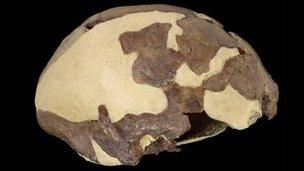Skull points to a more complex human evolution in Africa
- Published
Professor Chris Stringer compares one of the 13,000-year-old skulls (centre) with modern (l) and ancient (r) African fossils
Scientists have collected more evidence to suggest that ancient and modern humans interbred in Africa.
Reanalysis of the 13,000-year-old skull from a cave in West Africa reveals a skull more primitive-looking than its age suggests.
The result suggests that the ancestors of early humans did not die out quickly in Africa, but instead lived alongside their descendents and bred with them until comparatively recently.
The results are published in PLoS ONE, external.
The skull, found in the Iwo Eleru cave in Nigeria in 1965, does not look like a modern human.
It is longer and flatter with a strong brow ridge; features closer to a much older skull from Tanzania, thought to be around 140,000 years old.
Prof Katerina Harvati from the University of Tuebingen in Germany used new digitising techniques to capture the surface of the skull in detail.
The new technique improved upon the original measurements done with callipers by letting researchers see subtler details about the skull's surface.

The cast of the Iwo Eleru skull shows marks of a more ancient ancestor
"[The skull] has got a much more primitive appearance, even though it is only 13,000 years old," said Chris Stringer, from London's Natural History Museum, who was part of the team of researchers.
"This suggests that human evolution in Africa was more complex... the transition to modern humans was not a straight transition and then a cut off."
Prof Stringer thinks that ancient humans did not die away once they had given rise to modern humans.
They may have continued to live alongside their descendants in Africa, perhaps exchanging genes with them, until more recently than had been thought.
The researchers say their findings also underscore a real lack of knowledge of human evolution in the region.
But palaeontologists are not all agreed on precisely what the new analysis is telling us - or, indeed, whether it is telling us anything definitive at all.
"I do not think that these findings add anything new to our view," said Prof Clive Finlayson, director of the Gibraltar Museum, who was not connected to the study.
"We have a few fossils, and no idea of natural variation within populations. That the situation is not simple and is deep and complex is what we would expect.
"In my view, it is the field of genetics that will help us most in clarifying matters," he told BBC News.
Separate research published earlier this month suggests that genetic mixing between hominin species happened in Africa up to 35,000 years ago.